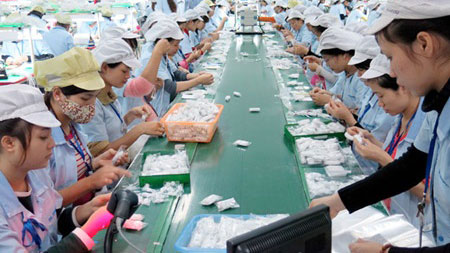
Vietnam is likely to attract US$22-US$23 billion worth of foreign direct investment this year, thanks to a strong on-year surge of 40.8% to US$19.3 billion in registered foreign capital during the last ten months.
Vietnam is likely to attract US$22-US$23 billion worth of foreign direct investment this year, thanks to a strong on-year surge of 40.8% to US$19.3 billion in registered foreign capital during the last ten months.
 |
| The Glonics Vietnam Ltd Company's headphone production line supplies Samsung. Vietnam expects to lure more projects worth billions of US dollars, like those from Samsung. |
According to the Ministry of Planning and Investment (MPI), as of October 2010, the country granted new investment certificates to 1,657 projects with the total registered investment capital of US$12.43 billion, up 26.9% and 24.8% year-on-year, respectively. It also allowed investors to add US$6.9 billion to 667 existing projects during the period.
Between January and October, a total of US$11.8 billion worth of foreign direct investment (FDI) was estimated to have been disbursed, up 16.3% year-on-year. Among the various sectors, the processing and manufacturing and real estate sectors continued to be the most attractive to foreign investors, with the total registered capital of US$12.5 billion, accounting for 64.7% of the country’s total FDI. The runners-up were electricity production and distribution, gas, hot water, steam and air conditioners, with US$2.62 billion.
Among the 59 countries and territories with investments in Vietnam during the 10-month period, Malaysia overtook Japan to become Vietnam’s second biggest foreign investor with US$2.52 billion in the newly-licensed registered and expanded capital, after the Republic of Korea (RoK) with nearly US$6 billion.
Speaking with VIR, Dang Xuan Quang, deputy head of the Foreign Investment Agency (FIA) under the MPI, attributed the impressive FDI attraction to bold changes in the country’s new investment policies, especially the issuance of the investment, business, and real estate laws, the improved business climate overall, which has risen three places on the World Bank’s business environment ranking, and the result of various free trade agreements.
Quang expressed his positive outlook regarding the feasibility of the FDI target this year, as many major foreign-invested projects are awaiting licensing.
According to the MPI, in the first ten months, new FDI projects were reported in 47 cities and provinces. The southern region, which includes Tra Vinh, Ho Chi Minh City, Dong Nai, and Binh Duong, were in the top four. In terms of the total registered capital, Tra Vinh took the lead with US$2.53 billion, followed by Ho Chi Minh City with US$2.3 billion, Dong Nai province with US$1.3 billion, Binh Duong province with US$1.14 billion, and Hanoi with US$791.6 million.
One province that achieved impressive FDI attraction was Dong Nai, which attracted an estimated US$2.15 billion worth of FDI as of mid-October, surpassing the whole-year target by over US$1.1 billion, with RoK, Taiwan, and Japan being the biggest foreign investors in processing and manufacturing, supporting industries, and hi-tech projects.
According to the Dong Nai Industrial Zones Management Authority (DIZA), in October, local industrial zones (IZs) lured an additional US$350 million, including nearly US$225 million worth of the total newly-registered investment capital. The DIZA credited the higher-than-targeted FDI to the provincial government’s effort to further streamline administrative procedures and implement investment promotion programmes abroad.
Remarkably, the Mekong Delta province of Tra Vinh has emerged as a promising destination for investors in recent months, thanks to a series of incentives, including financial assistance for land clearance compensation and infrastructure development for projects in the province-based economic and IZs, reduction in land rental fees and trade promotion expenses, as well as support for trademark registration.
According to the FIA, the sharp rise in the country’s FDI attraction during the 10-month span was attributed to the contribution of big foreign-invested projects. These included the Duyen Hai 2 thermal power plant in Tra Vinh with the total investment capital of US$2.4 billion invested by Malaysia’s Janakuasa Sdn.Bhd, and Samsung Display Vietnam’s additional capital of US$3 billion into its facility in the northern province of Bac Ninh.
The others were a US$1.2 billion real estate joint venture in Ho Chi Minh City, set up by several local firms and Denver Power Ltd from the UK, and Hyosung’s investment of US$660-million in a fibre production project in the southern province of Dong Nai.
In the southern province of Binh Duong, a typical example was the synthetic fibre and dyeing complex worth US$274.2 million by Far Eastern Polytex Vietnam Co.Ltd in the Bau Bang IZ.
The Glonics Vietnam Ltd Company's headphone production line supplies Samsung. Vietnam expects to lure more projects worth billions of US dollars, like those from Samsung.
(Source: VIR)





